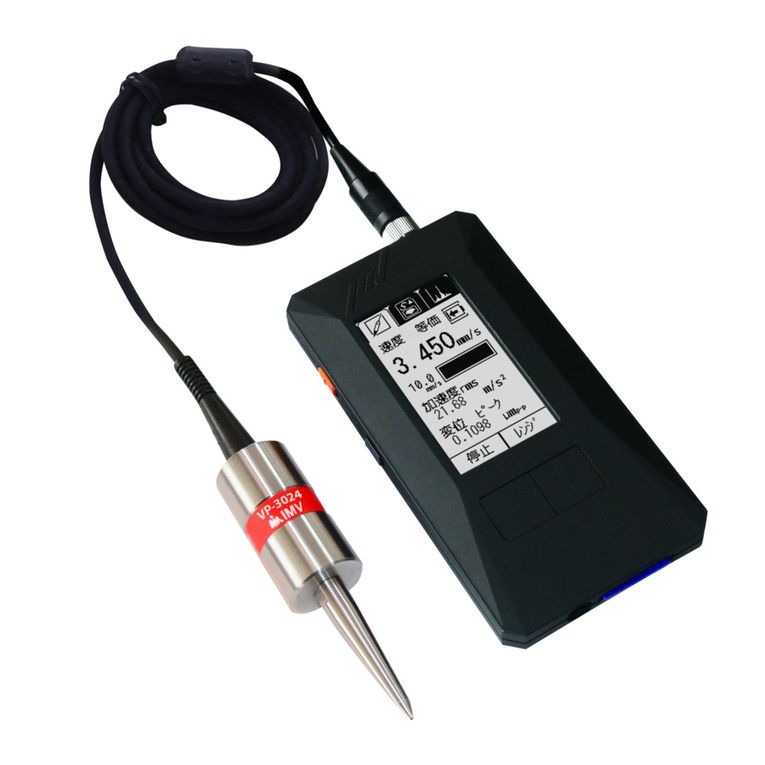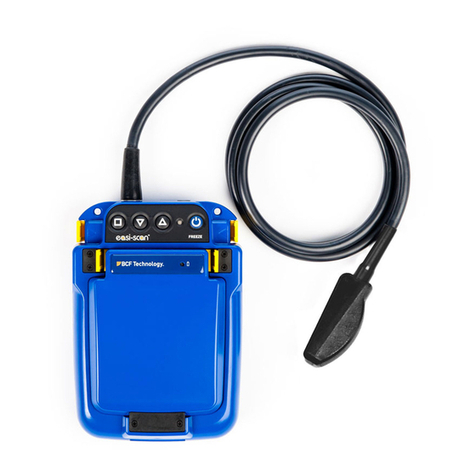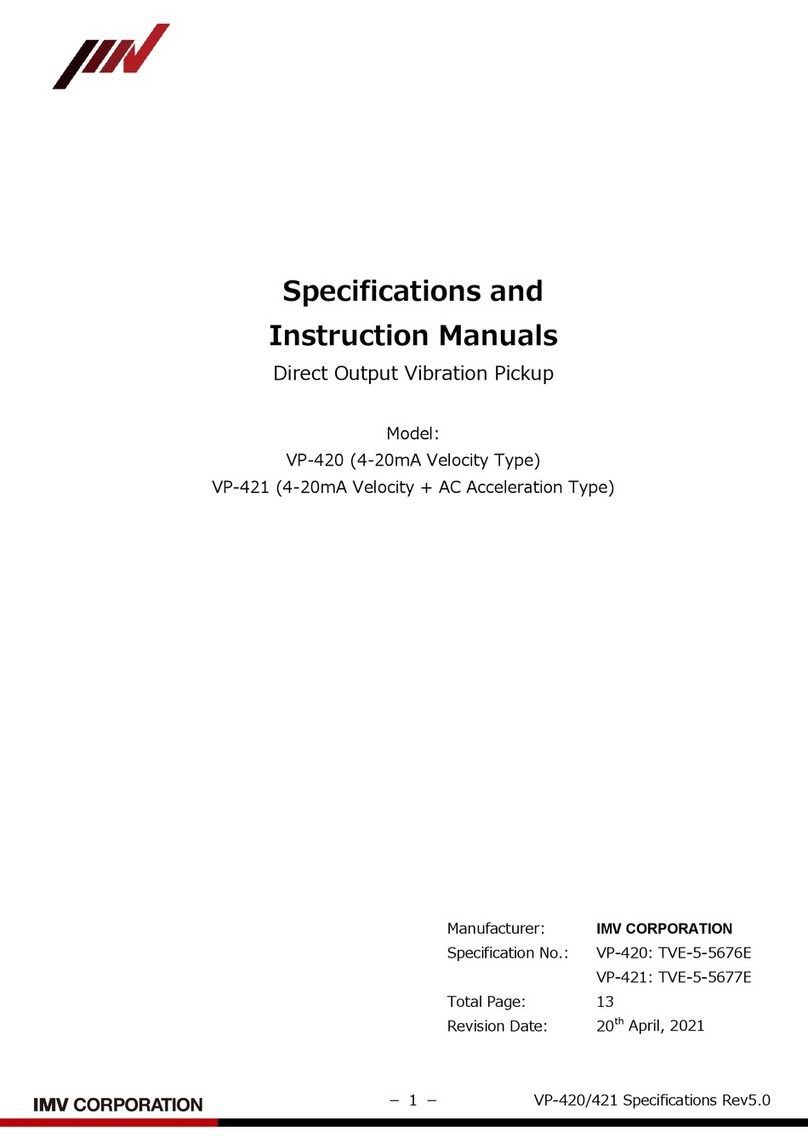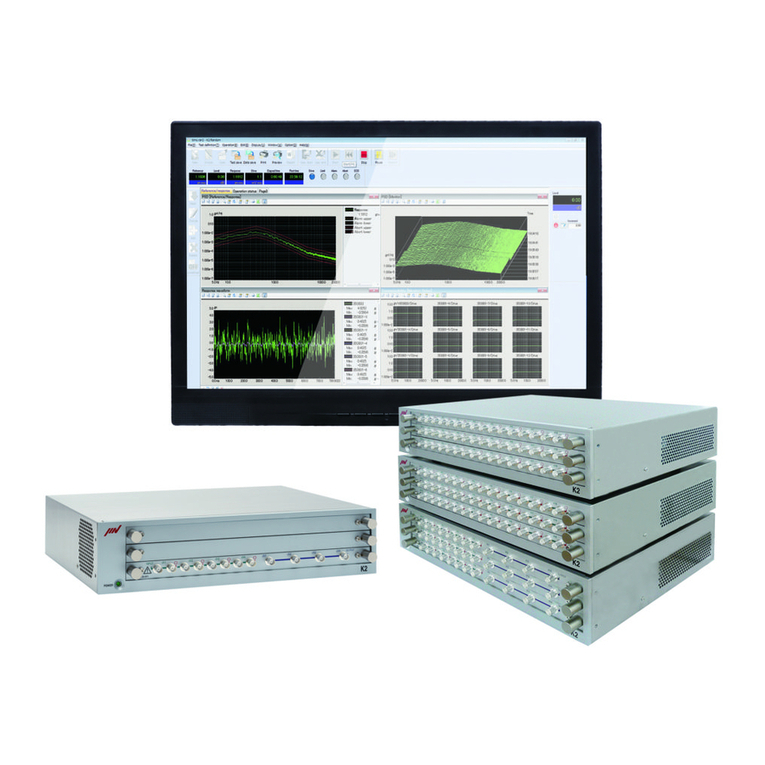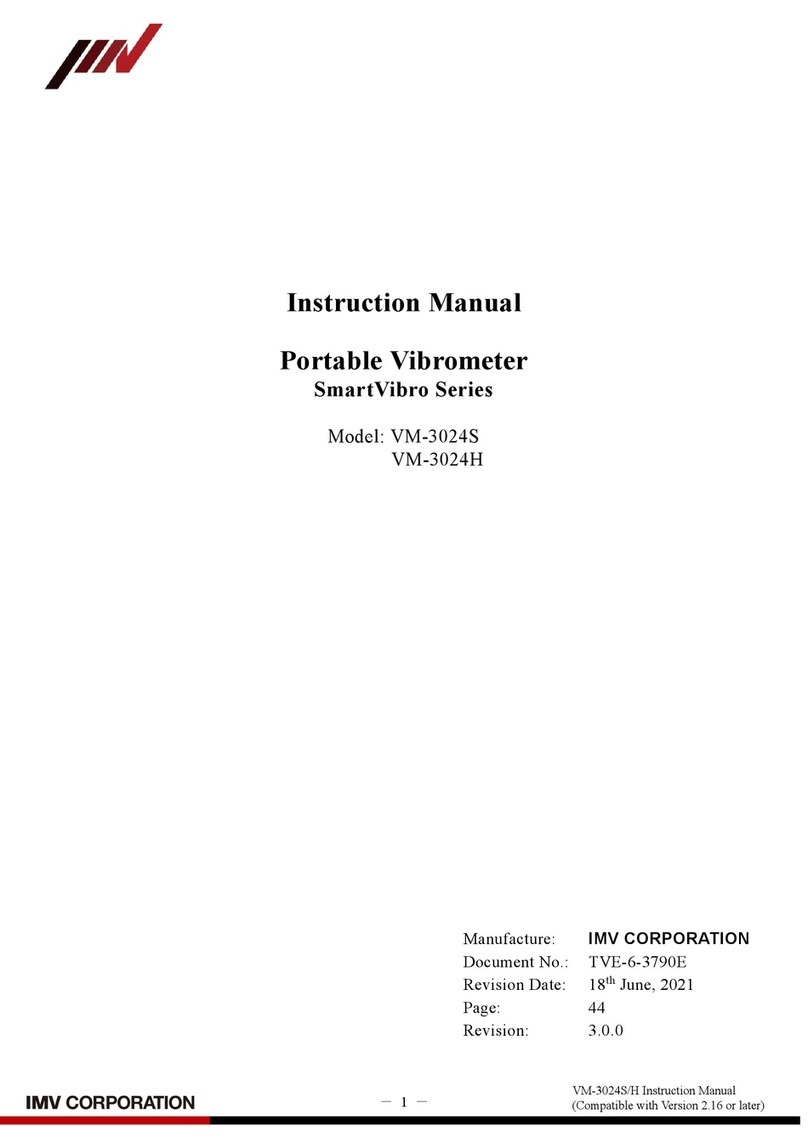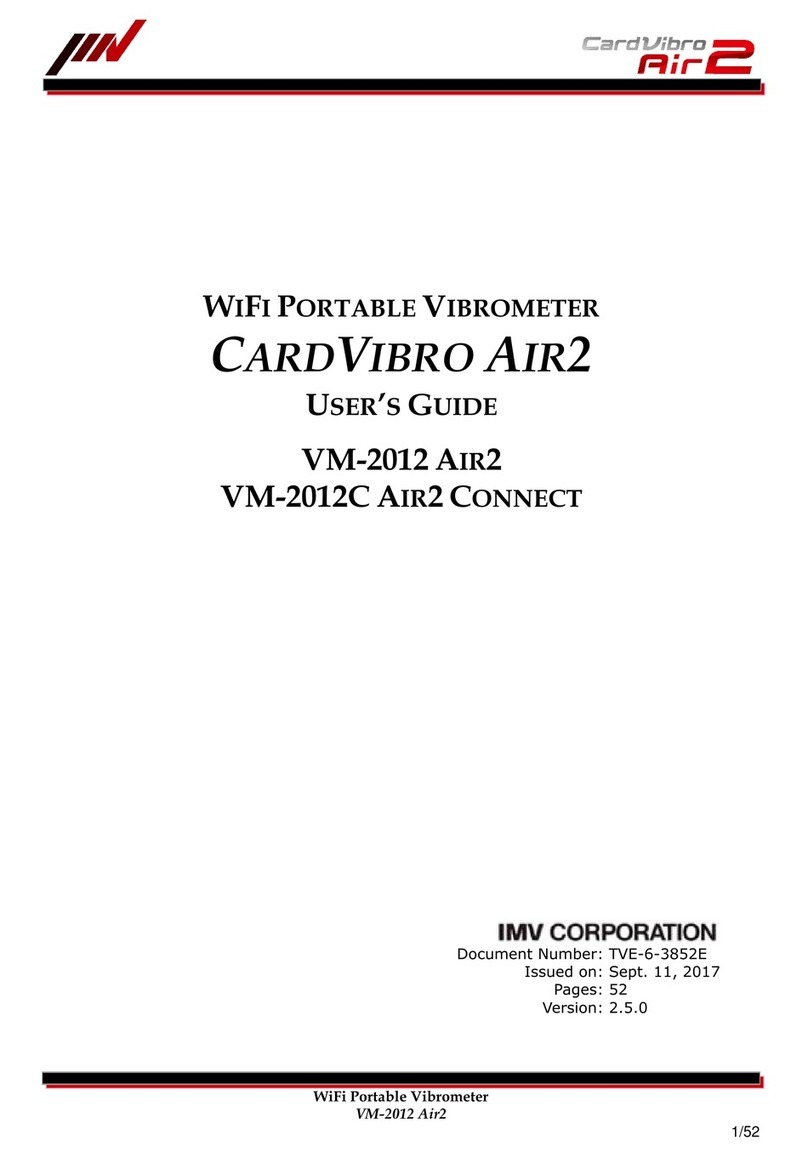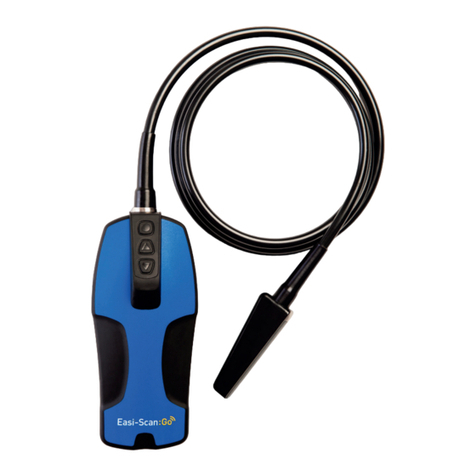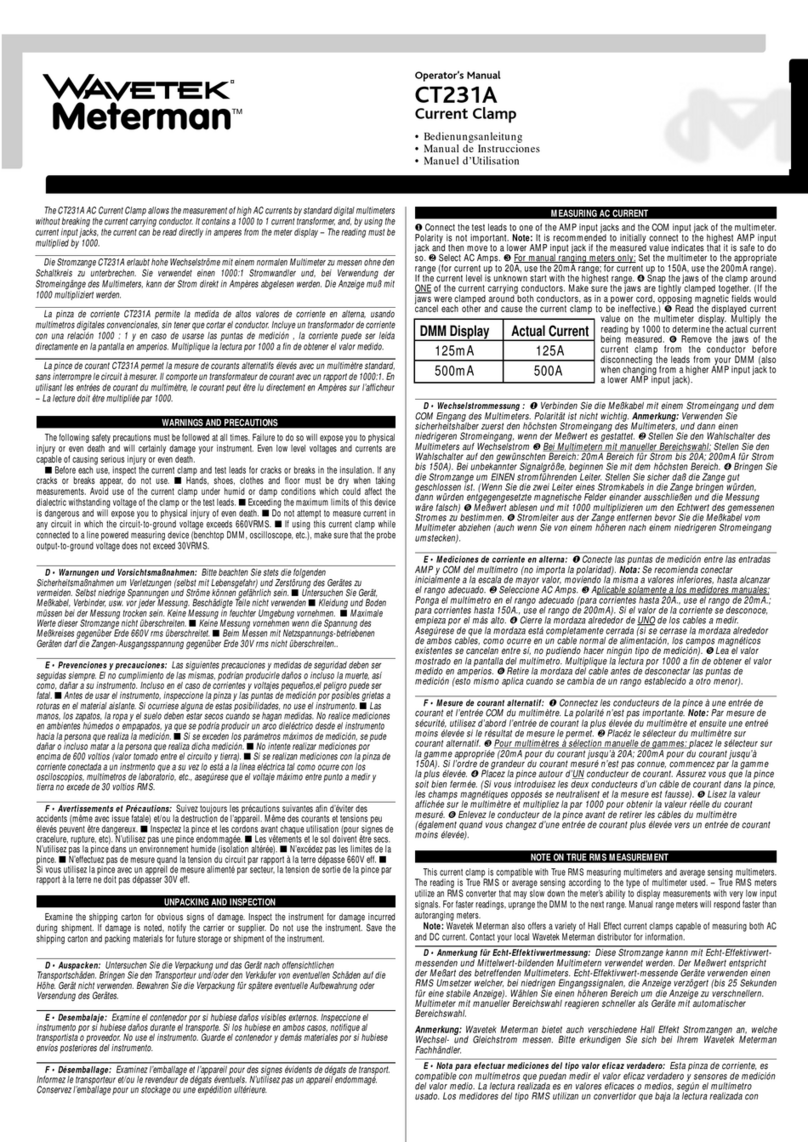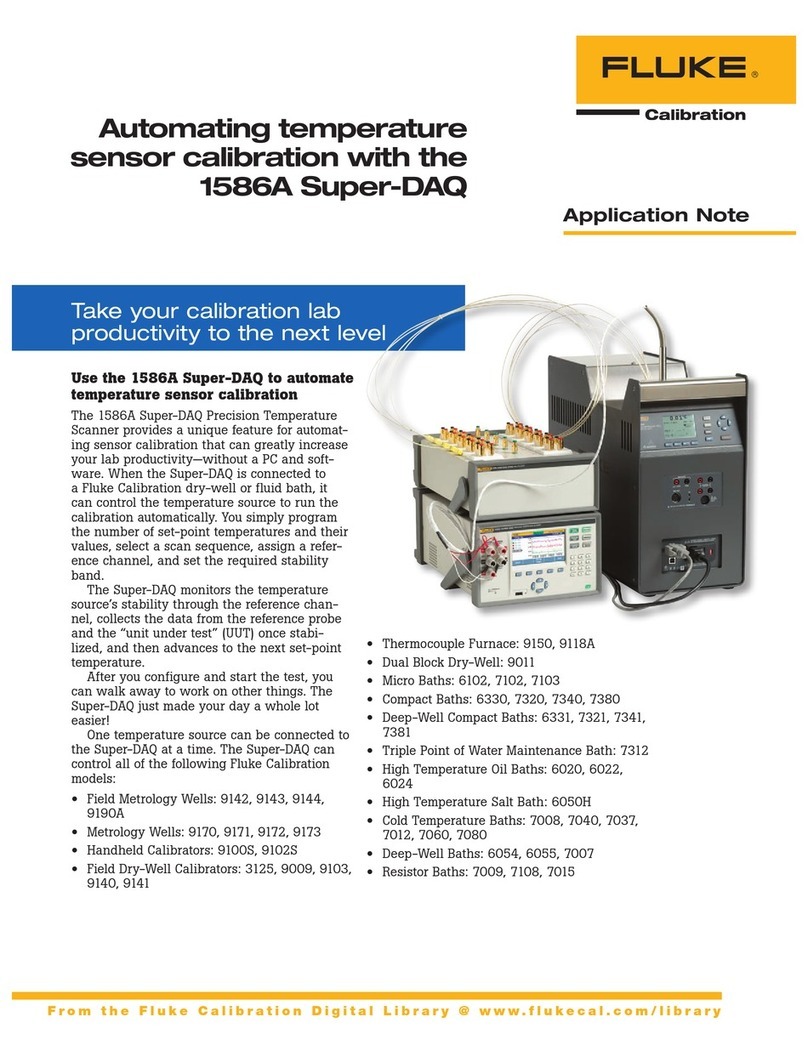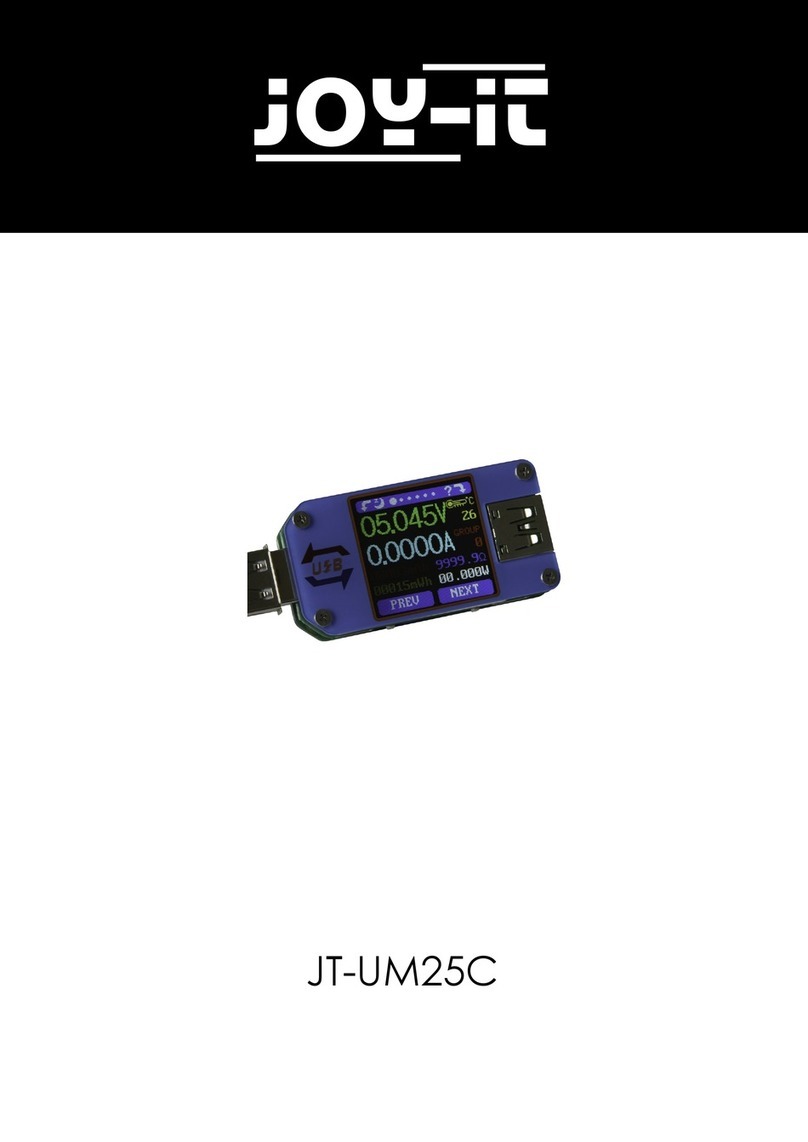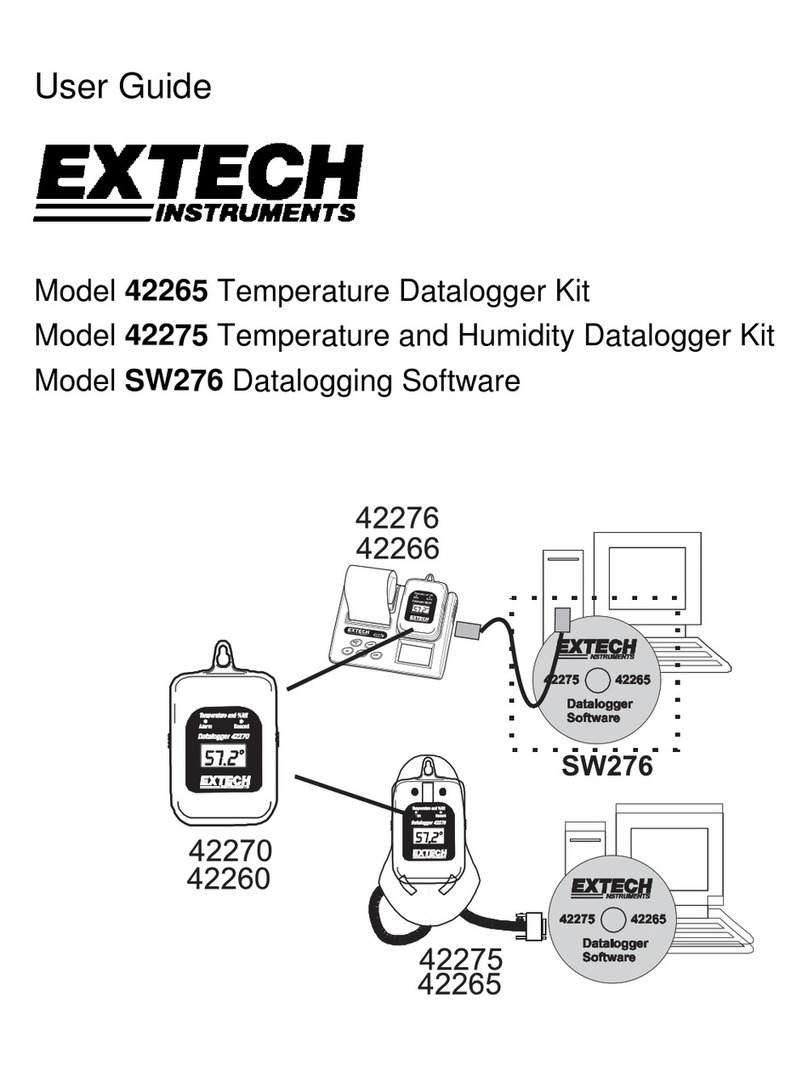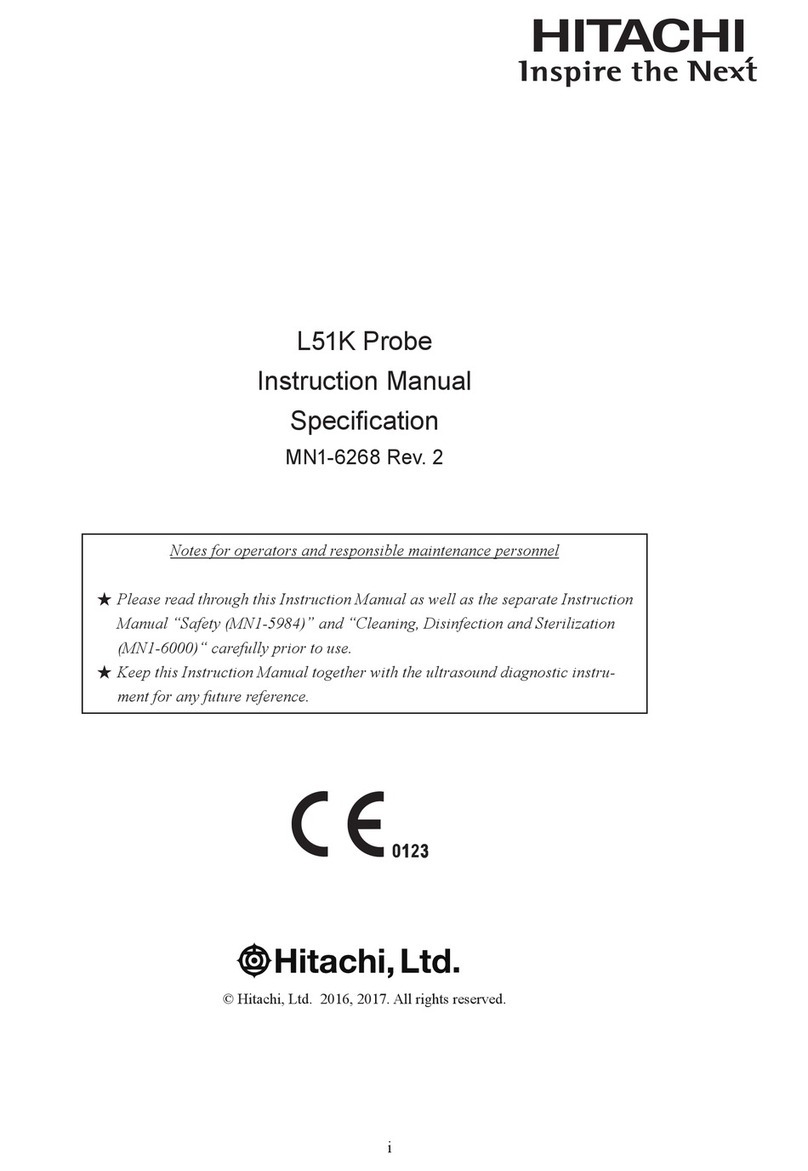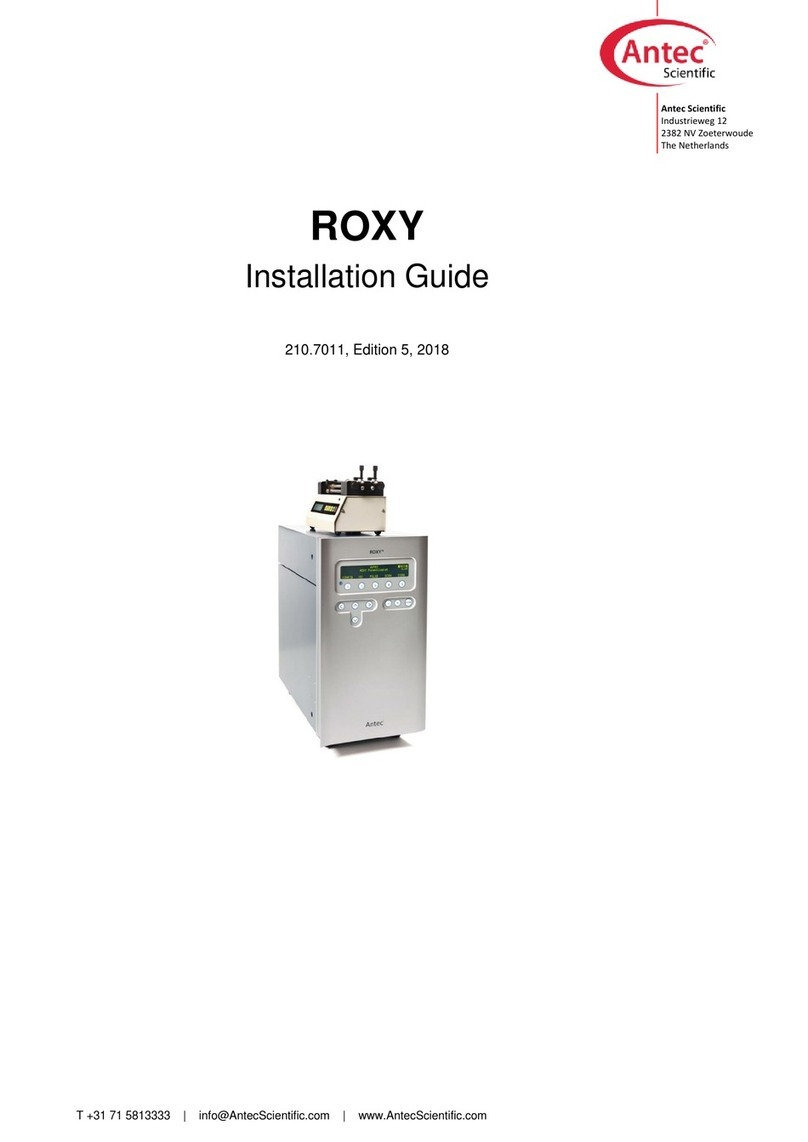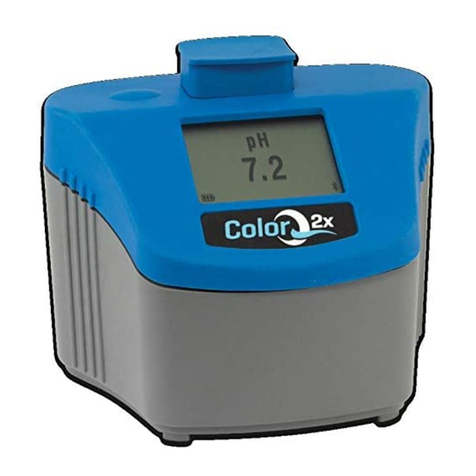IMV SmartVibro VM-7024H User manual

-1-
VM-7024H Instruction Manual
(Compatible with Version 2.16 or later)
Instruction Manual
Portable Vibrometer
SmartVibro Series
Model: VM-7024H
Manufacture: IMV CORPORATION
Document No.: TVE-6-3792E
Revision Date: 18th June, 2021
Page: 47
Version: 3.0.0

-2-
VM-7024H Instruction Manual
(Compatible with Version 2.16 or later)
Revision History
Date
Ver.
Details
8th May, 2012
1.0.0
New Issue.
24th July, 2012
1.0.1
Corrected Figures and phrases.
August, 2012
1.0.2
Corrected Phrases.
15th Oct, 2012 1.0.3
Add the sampling frequency for Data Save.
Add the Notation for Self-Check And FFT.
21th Dec, 2012
1.5.0
Add “Password Function”(4-14).
28th Jan, 2016
1.5.1
Corrected Ac Adapter Model Number.
10th July, 2019
2.0.0
Review the entire document.
1st Dec, 2019
2.0.1
Added content to “4-7-2. Version Information”.
18th June, 2021 3.0.0
(1) Ver2.16 or later compatible and overall review.
(2) Removed “Chinese” from language (end of support).
Important Notice
End of support about language display "Chinese"
The support of language display "Chinese" has ended 17th June, 2021.
Thank you in advance for your understanding.

-3-
VM-7024H Instruction Manual
(Compatible with Version 2.16 or later)
INDEX
1. Introduction ............................................................................................................................. 4
1-1. Panel Description.............................................................................................................. 5
1-2. Package Contents .............................................................................................................. 6
2. Outline..................................................................................................................................... 7
2-1. SmartVibro Overview ....................................................................................................... 7
2-2. Features............................................................................................................................. 7
3. Measurement ........................................................................................................................... 8
3-1. Before Getting Started ...................................................................................................... 9
3-2. Measurement Screen ....................................................................................................... 10
3-3. Operations during Measurement ......................................................................................11
4. Setting.................................................................................................................................... 13
4-1. Mode Setting................................................................................................................... 15
4-2. Calculation Setting.......................................................................................................... 16
4-3. Filter ............................................................................................................................... 18
4-4. Setting of Auto Range, Self-check, and Averaging ......................................................... 19
4-4-1. Setting of Auto Range .............................................................................................. 19
4-4-2. Self-Check Mode...................................................................................................... 20
4-4-3. Setting of Averaging................................................................................................. 21
4-5. Sensitivity Setting of AC and DC Output ....................................................................... 22
4-6. Setting of Battery Type, Auto Power Off, and Contrast.................................................. 24
4-6-1. Setting of Battery Type ............................................................................................ 25
4-6-2. Setting of Auto Power Off Function......................................................................... 25
4-6-3. Setting of Contrast ................................................................................................... 25
4-7. Language Setting ............................................................................................................ 26
4-7-1. Language Setting...................................................................................................... 26
4-7-2. Version Information ................................................................................................. 27
4-8. Password Function .......................................................................................................... 28
4-8-1. Password Setting ...................................................................................................... 28
4-8-2. Password Input......................................................................................................... 30
4-9. Battery Indicator ............................................................................................................. 31
5. FFT and Data Save ................................................................................................................ 32
5-1. FFT ................................................................................................................................. 32
5-1-1. FFT Indication.......................................................................................................... 32
5-1-2. FFT Setting .............................................................................................................. 34
5-2. Data Save ........................................................................................................................ 34
5-2-1. Waveform Data Save ................................................................................................ 34
5-2-2. Setting of Waveform Data Save ............................................................................... 37
6. Conversion Table ................................................................................................................... 39
7. Specifications ........................................................................................................................ 40
7-1. SmartVibro...................................................................................................................... 40
7-2. Pickup ............................................................................................................................. 40
7-3. Outer Dimensions of SmartVibro.................................................................................... 41
7-4. Outer Dimensions of Pickup ........................................................................................... 42
8. Troubleshooting..................................................................................................................... 43
9. Precautions ............................................................................................................................ 44
10. Fixing the pickup using a magnet (optional) ....................................................................... 44
11. Definitions ........................................................................................................................... 45
Appendix Filter Characteristic................................................................................................ 46

-4-
VM-7024H Instruction Manual
(Compatible with Version 2.16 or later)
1. Introduction
Thank you for purchasing Portable Vibrometer “VM-7024H”.
Please read this manual carefully before use and follow the cautions below for your safety.
Safety Precautions
This chapter describes several items which we would like to you observe in order to use
the product safety and prevent injury to customers and other persons and damage to
property. Please be sure to read this instruction manuals and attached documents before
use, and fully understand the contents for use.
After reading this manual, be sure to place it in a location so that you can always refer to it.
●Expressions of safety instructions
Calls attention to a procedure, practice, or condition that could possibly
cause death or bodily injury.
Calls attention to a procedure, practice, or condition that could possibly
cause bodily injury or damage to instrument.
Represent handling precautions or notes on product specifications.
Indicates product specification information and actual usage information.
●For safe use
In case of the place of objective instrument is high temperature, near rotating
shaft and near a moving element, the mounting of pick-up, please go to when
the machine is stopped.
In such a place, measuring the vibration with pick-up in one’s hand, it causes
burn injury and cable engulfment. It is very dangerous, please stop
absolutely.
Stop using the instrument, when producing smoke, bad smell or noise. It
causes fire or shock hazard.
Turn off the power switch and unplug the power cable from outlet as soon
as possible, please contact the agency or IMV. To reduce risk of injury, take
it to a qualified serviceman when service or repair is required.
Do not substitute parts or modify instrument.
It causes bodily injury, fire or shock hazard.
Stop using the instrument, when an object or liquid falls/spills into the
instrument. It causes fire or shock hazard.
Turn off the power switch and unplug the power cable from outlet as soon
as possible, please contact the agency or IMV.
Do not expose the instrument to moisture or dust.
If causes fire or shock hazard.
When replacing or disposing of the battery, follow the precautions on the
battery.
Also, pay attention to the polarity when replacing.
When the product is not used for a long time, turn off the power switch and
store it with the battery removed.
Storing the battery with the battery inside may cause a malfunction due to
liquid leakage.
Danger
Warning
Caution
Danger
Warning
Warning
Warning
Caution
Caution
Caution

-5-
VM-7024H Instruction Manual
(Compatible with Version 2.16 or later)
1-1. Panel Description
VM-7024H can be switched freely between Japanese and English.
Each screen display example is shown below.
(Japanese) (English)

-6-
VM-7024H Instruction Manual
(Compatible with Version 2.16 or later)
1-2. Package Contents
Product and Accessories for the VM-7024H.
(1) Basic Product and Accessories
Products
Qty
Model
Note
Figure
Main Unit
SmartVibro 1 VM-7024H
Accessories
Pickup 1 VP-7000L
Piezo resistive
Acceleration Type
Smart Vibro
Cable 1 CP-7000
3m straight cable with
metal connectors at both
ends.
Output Cable 1 -
1.5m cable with a plug at
one end.
For output to recorder
etc.
Battery 1 -AA Alkaline
Batteries
Instruction Manuals
1
-
with Inspection Sheet
SD Card 1 -
(2) Option Accessories
Products
Model
Note
Figure
1
Long Pickup
Cable
CE-7000 (10m)
To keep a distance from the
subject of measurement.
(Example)
2 Magnet MB-PB To fix the pickup on the
subject of measurement.
3 Cover PC-3024 Silicone jacket
4 AC Adapter PS-3024-3 100 to 240VAC
5 Carrying Case C-3024 To store the SmartVibro
and pickup.
Specifications and appearances of the items above are subject to change without notice.

-7-
VM-7024H Instruction Manual
(Compatible with Version 2.16 or later)
2. Outline
2-1. SmartVibro Overview
SmartVibro is a portable vibration meter with high-sensitivity and accuracy to measure
micro vibration of super low frequency.
Its application varies widely; measuring and analyzing vibrations, evaluation and
maintenance of the ground and/or floor of various architectural constructions, precision
machines in the laser and semiconductor industries, and low-speed machineries in energy
harvesting and hydroelectric generation.
2-2. Features
■Frequency Range
0.3 to 100Hz; Sensitivity: Full scale 0.1m/s2(Equivalent to 0.01G, 10Gal)
■Simultaneous Measurement
High-speed processing CPU enabled simultaneous display of acceleration, velocity and
displacement of velocity signal coming from the pickup.
■LCD Screen
Va r i ous settings like measurement conditions are possible by a touch panel.
■Acceleration Pickup
Square pickup can be attached to the subject of measurement in any orientation.
Durable acceleration: 300m/s2(30G)
■FFT Analysis Function
Real-time FFT analysis is possible with a minimum condition setting to check vibration
frequency components.
■Waveform Data Save
Waveform can be stored.
Stored data in the SD card can be exported to a personal computer.
■Language
VM-7024H can be switched freely between Japanese and English.

-8-
VM-7024H Instruction Manual
(Compatible with Version 2.16 or later)
3. Measurement
The names of each part of the main unit are as shown in Fig.3-1.
Fig.3-1 Vibrometer Main Unit
DC OUT:
DC output of measurement data
LCD Panel:
Displays and sets measured values.
Function Button:
Displays the setting screen, range
screen during measurement, etc.
Measurement Button
Starts/Stops measurement.
SD Card Slot:
Waveform data storage.
Power Connector:
AC adapter is available. (Optional)
Backlight Switch:
Turn ON/OFF backlight.
Power Switch:
Power ON/OFF
Connector:
Attach the pickup cable.
AC OUT:
AC output of measurement data.
Hand Strap Hole

-9-
VM-7024H Instruction Manual
(Compatible with Version 2.16 or later)
3-1. Before Getting Started
(1) You can select the computing method for velocity, acceleration, and displacement.
Refer to section 4-2 for more details. Initial settings are as follows:
■Acceleration (ACC): rms
■Velocity: rms
■Displacement: EQP
If you are familiar with our VM-7000L, EQP setting for the displacement is highly
recommended. Since the measurement data with the VM-7000L is indicated in EQP,
you may easily compare the data with the same setting.
(2) Check the polarity carefully, and set two AA batteries in the battery box (Ni-Cd or
Alkaline) (Fig.3-2).
For the use with the AC adaptor, connect the AC adapter cable to the power connector
in the bottom of the device.
(a) Installing AA batteries (b) Attaching the AC adapter
Fig.3-2 Power Supply Method
Pay attention to the polarity of the battery.
(3) Connect the pickup cable to the pickup connector.
In addition, when measuring, pickup installed or fixed for object. For actual measurement,
refer to the following sections.
Refer to section 10 when fixing the pickup.
(4) Display Language Setting
VM-7024H can switch between Japanese and English as needed. Refer to section 4-7.
+
+
DC Jack
Caution
Caution
Caution

-10 -
VM-7024H Instruction Manual
(Compatible with Version 2.16 or later)
3-2. Measurement Screen
Turn on the SmartVibro by sliding an orange switch on the left side of the device, initial
screen (Fig.3-3) will appear. Operate the device by using the touch screen and two function
buttons.
(Japanese) (English)
Fig.3-3 Initial Screen
(1) Standard Measurement Mode
You can measure the OA value of acceleration in this mode.
(2) Measurement Range Bar
This shows the level of measurement data. The data is not absolute, but rough
indication.
(3) Function Indicator
Valid functions are indicated.
In Fig.3-3, “Start” and “Setting” are operative.
(4) Measurement Button
In the measurement mode, start or hold measurement when you press this button. In
the setting mode, check the battery level (refer to section 4-9).
(5) Function Button
In the measurement mode, range display will appear when press this button. In the
FFT mode, this button would switch the display from detailed to simple indication
of the result, and vice versa (refer to section 5-1).
(6) Battery Indicator
This appears when the battery level is low.
(7) FFT
FFT mode starts when this tab is activated (refer to section 5-1).
(8) Data Save
Data save mode starts when this tab is activated. Waveform will be stored in the SD
card as plain text (refer to section 5-2).
(1)
(2)
(3)
(6)
(4) (5)
(7)
(8)

-11 -
VM-7024H Instruction Manual
(Compatible with Version 2.16 or later)
3-3. Operations during Measurement
Touching “Start” on the touch screen or press “Measurement Button” in Fig.3-3 would
start measurement. The screen displays measurement status (Fig.3-4).
Once touch “Hold” on the touch screen or press “Function Button” would hold
measurement and the display (AC output when stopped is not retained).
(Japanese)(English)
Fig.3-4 Display during Measurment
(1) How to change the Range
When the Auto Range function is “OFF” (refer to section 4-4.), the range key will
be activated during measurement (Fig 3-4).
Touching “Range” on the touch screen or pressing “Function Button” will show the
range setting display. You may adjust the range accordingly.
The icon will appear on the upper right corner of the screen when the value is
over the range (Fig.3-5).
(2) About Excessive Input State (Measurement Impossible State)
When is displayed on the upper right of the screen, regardless of main unit
version, input speed value exceeds the hardware range (amplifier gain), and the
waveform is distorted and unsuitableness state.
In this case, do not use it as a measurement value because it is not possible to
measure accurately.
Touch here to zoom in.
Caution

-12 -
VM-7024H Instruction Manual
(Compatible with Version 2.16 or later)
How to Zoom In
Touch the range bar area on the screen to zoom in the image (Fig.3-4). To zoom out,
touch the same area again (Fig.3-6).
(Japanese)(English)
Fig.3-5 Display during Changing the Range
(Japanese) (English)
Fig.3-6 Enlarged
Touch here to zoom out.
Range Up
Range Down
<Excessive Input State>
When this mark display appears,
the measured value is inaccurate.
Please measure with the mark
disappearing.

-13 -
VM-7024H Instruction Manual
(Compatible with Version 2.16 or later)
4. Setting
This section explains how to make various settings such as measurement mode.
As shown in Fig.4-1, the setting screen will appear when press “Function Button” when
“setting” is indicated in the function indicator (Fig.4-2).
(Japanese)(English)
Fig.4-1 “Setting” in the Function Indicator
(Japanese)(English)
Fig.4-2 Mode and Calculation Setting Screen

-14 -
VM-7024H Instruction Manual
(Compatible with Version 2.16 or later)
The setting screen can be switched by touching the icon at the top of the screen (Fig.4-3).
(Japanese) (English)
Fig.4-3 Switching the setting screen
Switching is in the following order.
If “Next Page” is displayed on the setting screen, touch it to display the settings for the
second and subsequent pages (Fig.4-3).
Setting Icon

-15 -
VM-7024H Instruction Manual
(Compatible with Version 2.16 or later)
4-1. Mode Setting
When “Vel.” is selected for the Mode (Fig.4-4), the physical amount is shown at the top
of the measurement screen. Also, the enlarged screen will show the physical amount
accordingly.
(Japanese) (English)
Fig.4-4 Mode Setting
In “Mode”, the setting mode changes in the following order each time the button is
touched.
After setting mode, press the “Meas.” button or touch "Meas.", return to the
measurement screen (Fig.4-5).
(Japanese) (English)
Fig.4-5 How to return to the Measurement Screen
Vel.
Acc.
Disp.

-16 -
VM-7024H Instruction Manual
(Compatible with Version 2.16 or later)
4-2. Calculation Setting
You can set how to indicate the physical amount of measurement results in calculation
setting (Calc.).
As you touch “Set” in Fig.4-2, Fig.4-6 will appear.
(Japanese) (English)
Fig.4-6 Calculation Setting
The calculation method selected in Fig.4-6 will be displayed on the screen (Fig.4-7).
(Japanese) (English)
Fig.4-7 Example of the Setting Screen

-17 -
VM-7024H Instruction Manual
(Compatible with Version 2.16 or later)
Calculation settings change each time the button is touched.
Switching is in the following order.
Acc.
Vel.
Disp.
(1) A brief Description of each Calculation Method
rms: “rms” is “Root Mean Square”. This is the square root of the mean of the squares
of the time-series data gathered from measurement. ISO standard sets RMS as
evaluation criteria of the vibration velocity, which is also known as vibration
severity.
EQP: EQP is a value gained by “rms”× √2
. This formula is suitable to use for
measurement of sine vibration generated by rotational machines, for example.
Peak: The maximum value of the time-series data.
For detailed explanation, refer to the definitions in Section 10.
(2) Setting of VM-7000L
When had used VM-7000L in past, should not use “Peak” setting, but use the same
setting as VM-7000L.
Recommended setting for VM-7024H are as shown in the table below.
Model
VM-7000L
VM-7024H
Acc.
rms
rms
EQP
EQP
Vel.
rms
rms
EQP
EQP
Disp.
EQP
EQP
―
Peak
rms
EQP
Peak
EQP
Peak

-18 -
VM-7024H Instruction Manual
(Compatible with Version 2.16 or later)
4-3. Filter
Change the settings of high-pass (HPF) and low-pass filters (LPF).
Pressing “Set” would bring you to the screen indicated in Fig.4-8.
By touching the triangles on the screen ( or ), you can change the frequency of each
filter.
(Japanese) (English)
Fig.4-8 Example of Filter Setting
The range of filter is as follows:
Filter
Minimum
Setting
Maximum
Setting
Setting Step
HPF
0.3Hz
50.0Hz
0.1Hz
LPF
10Hz
100Hz
10Hz
About Filter Setting
(1) 「Set “LPF setting value” larger than “HPF setting value”.
If “LPF setting value” is smaller than “HPF setting value”, the filter setting
screen cannot be closed. Be sure to set “LPF setting value > HPF setting value”.
(2) Please refer to “Appendix” for filter characteristics.
Caution

-19 -
VM-7024H Instruction Manual
(Compatible with Version 2.16 or later)
4-4. Setting of Auto Range, Self-check, and Averaging
To set Auto Range, Self-check and Averaging, select tab on the setting screen.
(Japanese) (English)
Fig.4-9 Setting Page of Auto Range, Self-check, and Averaging
Touching “Next Page” changes to the data saving and FFT function setting screen for
the second page. Refer to section 5-1. for these settings.
4-4-1. Setting of Auto Range
When auto range is "ON", range will be adjusted automatically during measurement
(Fig.4-9). “Range” will not be indicated on the measurement display. In this case,
“Function Button” is not effective (Fig.4-10).
You can switch between “ON” and “OFF” by touching Auto Range button on the
screen.
(a) Auto Range is “ON” (b) Auto Range is “OFF”
Fig.4-10 Measuring Screen of Auto Range “ON” and “OFF”

-20 -
VM-7024H Instruction Manual
(Compatible with Version 2.16 or later)
4-4-2. Self-Check Mode
By reversing the pickup vibration detection direction in the direction of gravitational
acceleration (vertical) and checking the static acceleration of ±9.8m/s2(±1G), it is
possible to easily determine whether there is a pickup abnormality.
(1) Connect an oscilloscope or digital voltmeter to DCOUT.
※Device is select "DC measurement mode".
(2) “DC OUT Sens” select 30m/s2/V (refer to section 4-5)。
(3) Self-check is “ON”.
(4) When pressed “Measurement Button” and measurement is started, the display
automatically changes to the range of 20m/s2rms and the numerical value is displayed.
(5) If the detecting arrow mark of pickup is set upper direction or lower direction for ground,
pickup will generate a static acceleration of approximately ±9.8m/s2by the gravitational
acceleration.
(6) Since DCOUT Sens is 30(m/s2)/V, it is good if about 0.327V±5% is output
(7) Next, if the detecting arrow mark of pickup is set horizontal direction for ground, output
voltage and acceleration value is approximately zero.
(Japanese) (English)
Fig.4-11 Setting Page of Self-check
When using this mode, regardless of the measurement mode setting (Fig.4-
1), the top
display is acceleration, and the range is fixed at 20m/s2rms (range change is disabled).
After the self-check is completed, set the self-check to “OFF” on the setting screen (normal
vibration measurement cannot be performed if the self-check is left on).
Table of contents
Other IMV Measuring Instrument manuals
Popular Measuring Instrument manuals by other brands
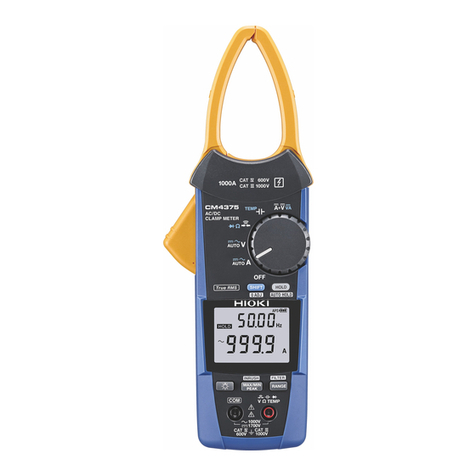
Hioki
Hioki CM4375 instruction manual
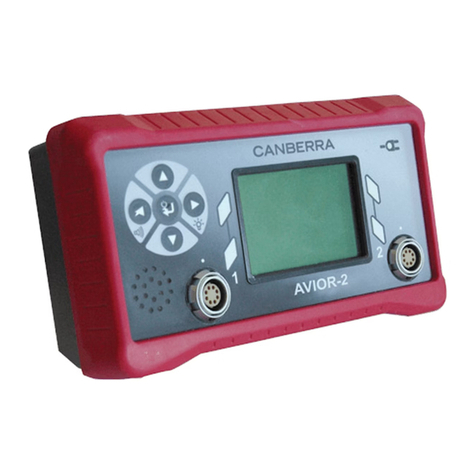
Mirion Technologies
Mirion Technologies AVIOR-2 user manual
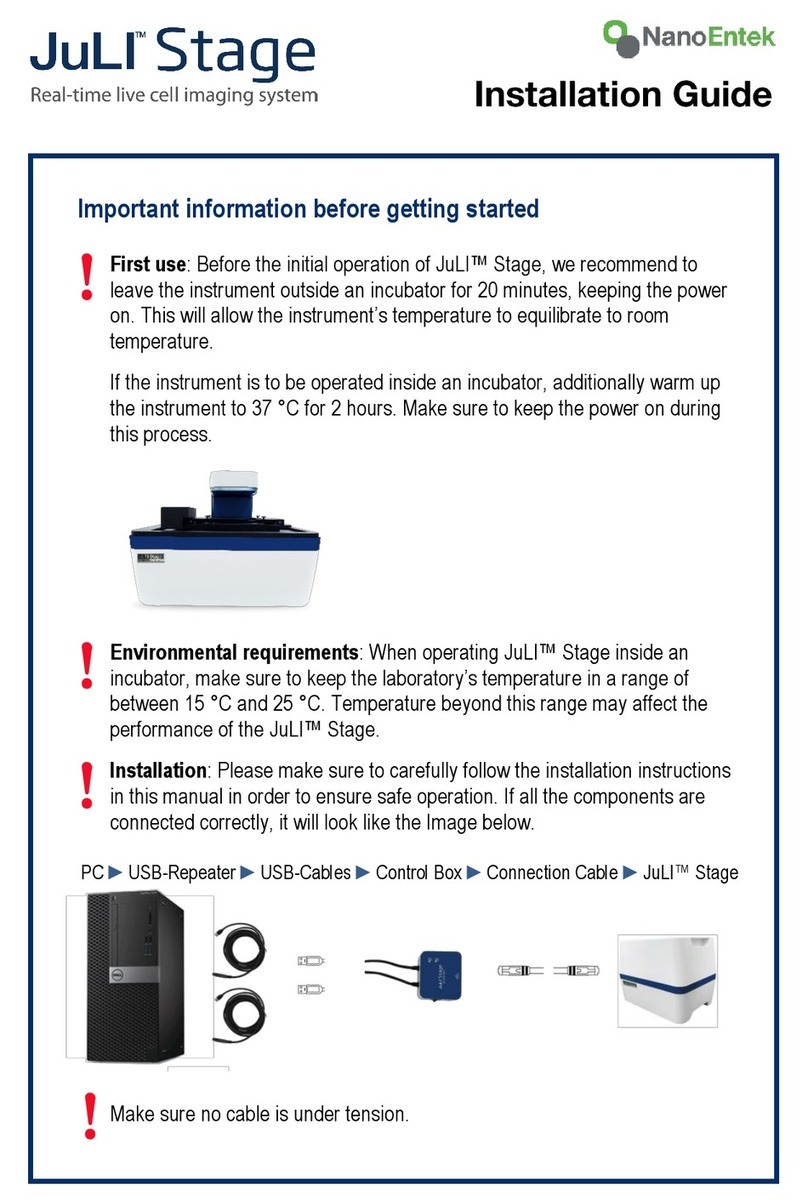
NanoEnTek
NanoEnTek JuLi Stage installation guide
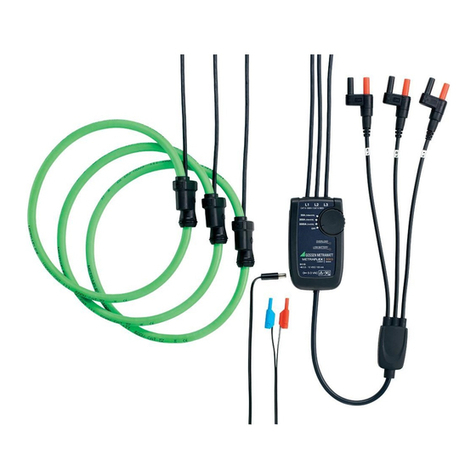
Gossen MetraWatt
Gossen MetraWatt METRAFLEX 3000 operating instructions

ROOTECH
ROOTECH Accura 2350-GW user guide
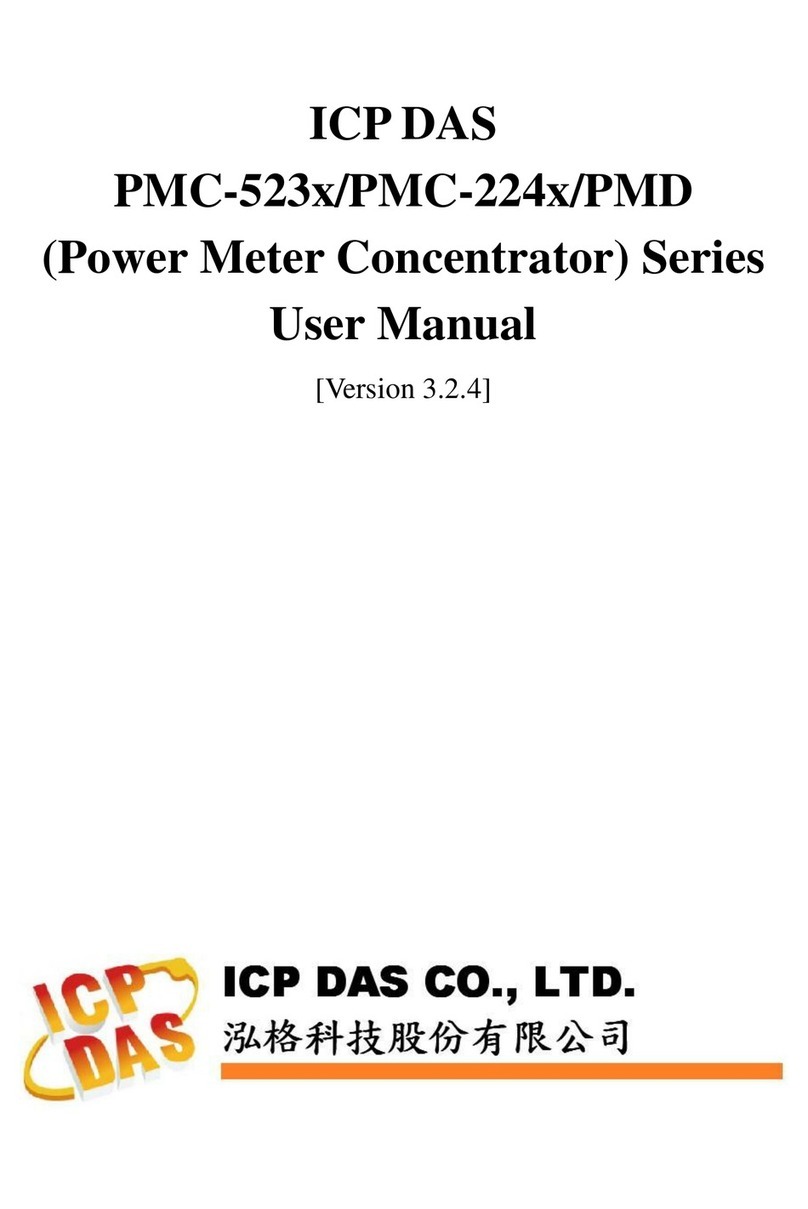
ICP DAS USA
ICP DAS USA PMC-523 Series user manual
